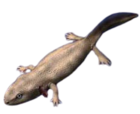| Rhinatrema | |
|---|---|
| Scientific classification | |
| Domain: | Eukaryota |
| Kingdom: | Animalia |
| Phylum: | Chordata |
| Class: | Amphibia |
| Order: | Gymnophiona |
| Clade: | Apoda |
| Family: | Rhinatrematidae |
| Genus: | Rhinatrema Duméril and Bibron, 1841 |
| Type species | |
| Caecilia bivittata Guérin-Méneville, 1838 | |

Rhinatrema is a genus of caecilians in the family Rhinatrematidae. Their common name is two-lined caecilians. The genus is known from the Guyanas (Guyana, French Guiana, and Suriname) and adjacent Brazil. Most Rhinatrema are known to inhabit and live in areas of tropical forests where there is an abundance of dense, dead vegetation matter.
Rhinatrema are primitive caecilians that have a true tail. They are oviparous.
Until recently, the two-lined caecilian (R. bivittatum) was the only species in the genus Rhinatrema. However, in 2010 and 2018, new species were described. The genus now contains now six species:
| Binomial name and author | Distribution | Status |
|---|---|---|
| Rhinatrema bivittatum (Guérin-Méneville, 1838) | Guyana, Surinam, French Guiana, Brazil | Least Concern |
| Rhinatrema gilbertogili Maciel, Sampaio, Hoogmoed, and Schneider, 2018 | Brazil | Not evaluated |
| Rhinatrema nigrum Dunn, 1942 | Guyana, Venezuela, possibly Brazil | Least Concern |
| Rhinatrema ron Wilkinson and Gower, 2010 | Brazil | Not evaluated |
| Rhinatrema shiv Gower, Wilkinson, Sherratt, and Kok, 2010 | Guyana | Not evaluated |
| Rhinatrema uaiuai Maciel, Sampaio, Hoogmoed, and Schneider, 2018 | Brazil | Not evaluated |
References
- ^ Frost, Darrel R. (2014). "Rhinatrema Duméril and Bibron, 1841". Amphibian Species of the World: an Online Reference. Version 6.0. American Museum of Natural History. Retrieved 29 May 2014.
- ^ "Rhinatrematidae". AmphibiaWeb: Information on amphibian biology and conservation. . Berkeley, California: AmphibiaWeb. 2014. Retrieved 29 May 2014.
- Jared, C; Navas, C.A; Toledo, R.C (1999). "An appreciation of the physiology and morphology of the Caecilians (Amphibia: Gymnophiona)". Comparative Biochemistry and Physiology Part A: Molecular & Integrative Physiology. 123 (4): 313–328. doi:10.1016/S1095-6433(99)00076-8.
- Vitt, Laurie J.; Caldwell, Janalee P. (2014). Herpetology: An Introductory Biology of Amphibians and Reptiles (4th ed.). Academic Press. p. 449.
- Philippe Gaucher; Ross MacCulloch; Mark Wilkinson; Marvalee Wake (2004). "Rhinatrema bivittatum". IUCN Red List of Threatened Species. 2004: e.T59647A11975672. doi:10.2305/IUCN.UK.2004.RLTS.T59647A11975672.en. Retrieved 26 April 2023.
- IUCN SSC Amphibian Specialist Group. (2020). "Rhinatrema nigrum". IUCN Red List of Threatened Species. 2020: e.T59643A109542103. doi:10.2305/IUCN.UK.2020-3.RLTS.T59643A109542103.en. Retrieved 26 April 2023.
| Taxon identifiers | |
|---|---|
| Rhinatrema | |
This caecilian article is a stub. You can help Misplaced Pages by expanding it. |



